Understanding Ambiguity
The term “anti-Hindu” is an ambiguous word, leaving us wondering what truly constitutes a film as anti-Hindu. Does it require explicit portrayal of Hinduism or Hindutva or its symbols to be considered pro-Hindu?
And who has the authority to determine these categorizations?
Before answering these questions and understanding the anti-Hindu or pro-Hindu elements in the Tamil film industry, let’s talk about Hinduism and its nuances.
Exploring the Nuances
Through conversations with a diverse range of individuals, including liberals and ultra right-wing fanatics, I’ve discovered that the true depth and adaptability of Hinduism often go unnoticed.
When compared to Abrahamic religions, Hinduism stands out with its tolerance and flexibility, offering a unique perspective. Hindusim doesn’t believe in Supremacy of one god and it help the followers to be tolerant to other religions & beliefs.
Now, let us see the essence of Hindusim, through the lens of a liberalist.
Hinduism: Beyond Religion
Hinduism transcends conventional religious boundaries and encompasses a way of life and a rich cultural framework. It move into profound existential questions, explores the purpose of life, and intricately examines the relationship between humanity and the divine.
At its core, Hinduism is way of life (just like Democracy), shaping a holistic worldview (Loka samstha sukhino bhavanathu).
Fundamental Philosphies
To understand how South movies, especially Tamil films, promote Hinduism, it is essential to explore some of the unique philosophies within the religion.
These philosophies form the very foundation of many Tamil films, resonating with audiences and communicating profound messages.
The Cycle of Rebirth
Reincarnation, a central belief in Hinduism, explores the concept of the soul’s successive rebirth in new bodies after death.This aligns with the idea of a cyclic theory of time, where the divine takes multiple incarnations to restore cosmic harmony.
Sambhavami Yuge Yuge.. He incarnates again and again.
“Yada yada hi dharmasya glanir bhavati Bharata, abhyutthanam adharmasya tadatmanam srjamyaham.” (Chapter 4, Verse 7, Bhagavat Gita)
Translation: “Whenever there is a decline in righteousness and an increase in unrighteousness, O Arjuna, I manifest Myself on earth.”
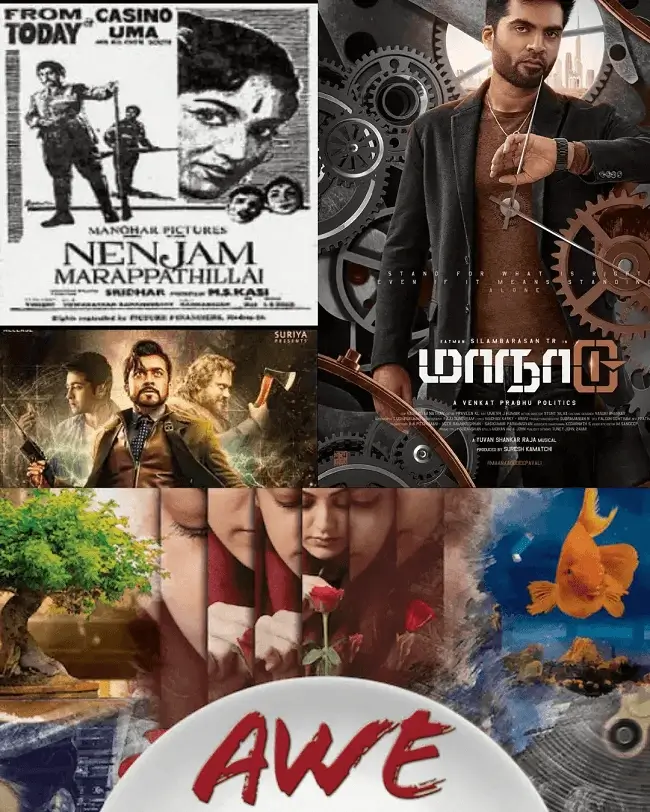
From 1963 film “Nenjam Marappathillai” to Films like “Maanaadu,” or the bilingual film “Awe” directed by Prashanth Varma, or Suriya’s “24,” and Vishnu Vishal’s “Indru Netru Naalai” beautifully showcase this philosophy of reincarnation or cyclic theory of time.
Atman and Brahman
Hinduism introduces the concept of Atman, which refers to the individual self or soul. Hinduism believes that Atman is eternal and intricately connected to the god or divine power known as Brahman. Unlike the Abrahamic religions that view the soul as a distinct, separate entity created by God, Hinduism emphasizes the inseparability of the individual self (soul) from the divine.
“The self is never born nor does it ever die; nor having come to be will it ever cease to be. The self is unborn, eternal, ever-existing, undying, and primeval.” (Chapter 2, Verse 20)
“Ayamatma Brahma” or “Aham Brahmasmi” are some vedic texts which supports this.
This fundamental philosphy is different from the idea of resurrection.
While Abrahamic religions such as Christianity, Islam, and Judaism believe in the resurrection of the physical body in a transformed state, Hinduism presents a different perspective.
Tamil Films Promoting this Core Philosophies are many. Let’s explore a few remarkable examples:

Kamal Hassan’s “Anbe Sivam” (2003)
This thought-provoking film revolves around the concept of “Ayam Atma Brahma,” highlighting the belief that the divine essence resides within each of us. It celebrates the profound connection between individuals and the divine, fostering empathy, compassion, and spiritual growth.

Bala’s “Naan Kadavul” (2009)
Directed by Bala, “Naan Kadavul” embodies the essence of Hindu philosophies with its exploration of divine intervention, the paths of karma, and the transformative power of devotion. It delves into the complexities of human existence, while emphasizing the cosmic interconnectedness between mortals and the divine.
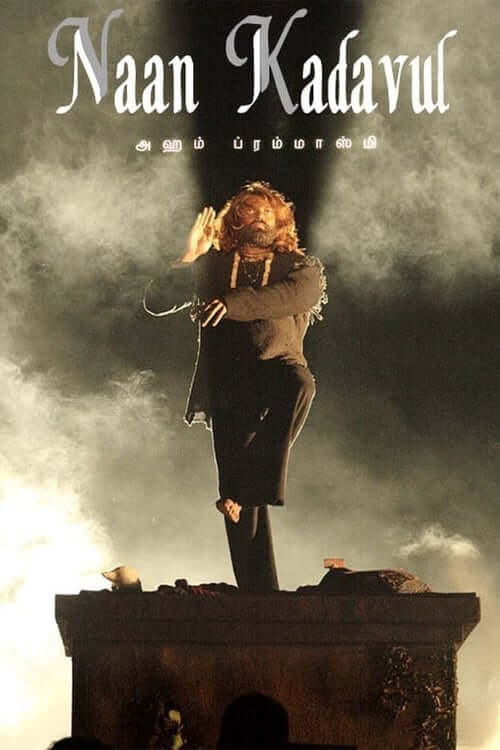
“Karnan” by Mari Selvaraj
“Karnan” weaves a powerful narrative rooted in social justice and equality, drawing inspiration from ancient Hindu epics. It highlights the struggles of the marginalized and champions the notion of dharma (righteousness) against oppression, the hero is supported by the soul of his sister.

This list won’t ends here, it’s long.
Diverse Paths to Salvation
In Hinduism, individuals have the freedom to choose from multiple paths to attain spiritual liberation.This is in contrast to Abrahamic religions, which often advocate a more singular path to salvation
Karma Yoga
Karma Yoga advocates selfless service as a means to spiritual growth. It emphasizes performing actions with a sense of duty, without seeking personal gain. Tamil heroes often deliver dialogues that reflect this philosophy, inspiring audiences with the importance of altruistic heroism.
“Karmanye vadhikaraste Ma Phaleshu Kadachana, Ma Karma Phala Hetur Bhurmatey Sangostva Akarmani.” (Chapter 2, Verse 47)
Krishna advises Arjuna to focus on his duty without being attached to the outcomes or being driven by personal desires. He emphasizes the importance of selfless action.
Bhakti Yoga
Bhakti Yoga focuses on devotion and love for the divine. It involves cultivating a deep and personal relationship with a chosen deity or form of the divine. While this philosophy was more prominent in the 80s and 90s, its representation has become relatively rare in contemporary Tamil cinema.
Jnana Yoga
Jnana Yoga centers around knowledge and wisdom. It emphasizes the pursuit of self-realization and understanding the true nature of oneself and the universe. Modern Tamil heroes and heroines often embody this philosophy, celebrating personal freedom and intellectual introspections.
Tamil Films Showcasing Diverse Paths & Moksha
Films like “Oh My Kadavule” (2020), Thiagaraja Kumaraja’s “Super Deluxe,” Vikram’s “Anniyan,” Manikandan’s “Kadaisi Vivasayi” and Suriya’s “7 am Arivu” serve as noteworthy examples that showcase the philosophy of diverse paths to salvation and talks about Moksha. These films explore different aspects of the paths to liberation, offering audiences thought-provoking narratives that inspire introspection and self-discovery.
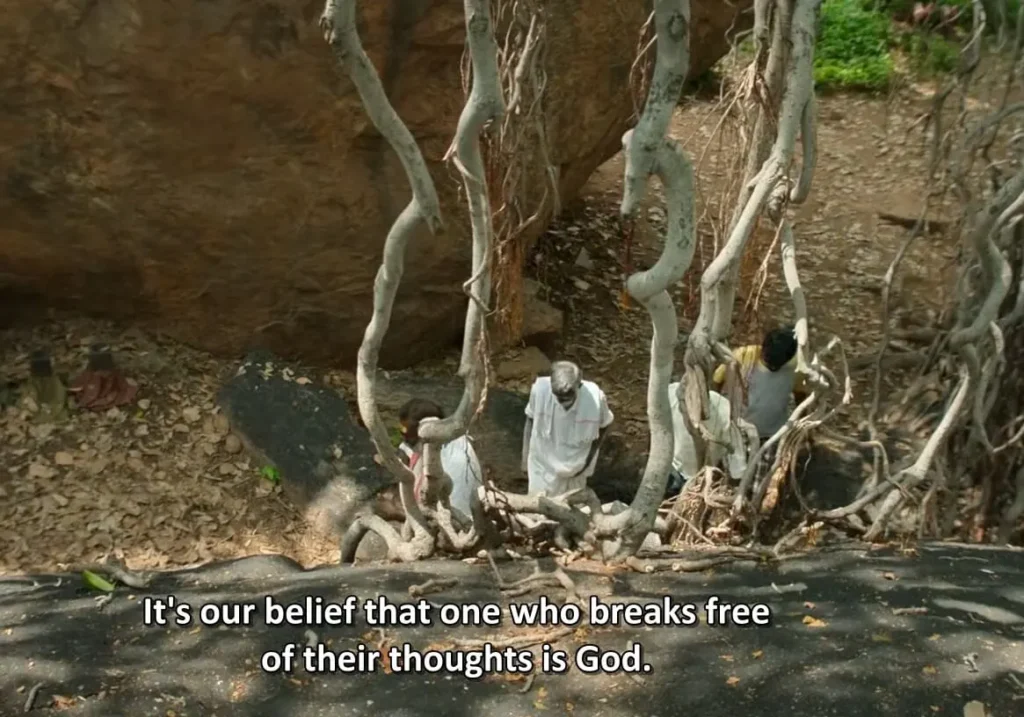
Karma vs. Divine Judgment
Hinduism introduces the profound concept of Karma, where the consequences of one’s actions and intentions shape their future experiences and circumstances. Even God can’t escape Karma.
In contrast, Abrahamic religions emphasize the concept of divine judgment, where individuals are held accountable for their actions and face rewards or punishments in an afterlife.
In simpler terms, irrespective of prayers, good deeds, or repentance, Karma remains as a nasty b**ch which follows individuals throughout their lives. Tamil cinema frequently explores these themes, offering thought-provoking narratives that showcase this nasty face of Karma.
Prominent Examples which explore Karma in Tamil Cinema
Tamil films have explored the depths of Karma, presenting captivating stories that reflect the consequences of one’s actions.
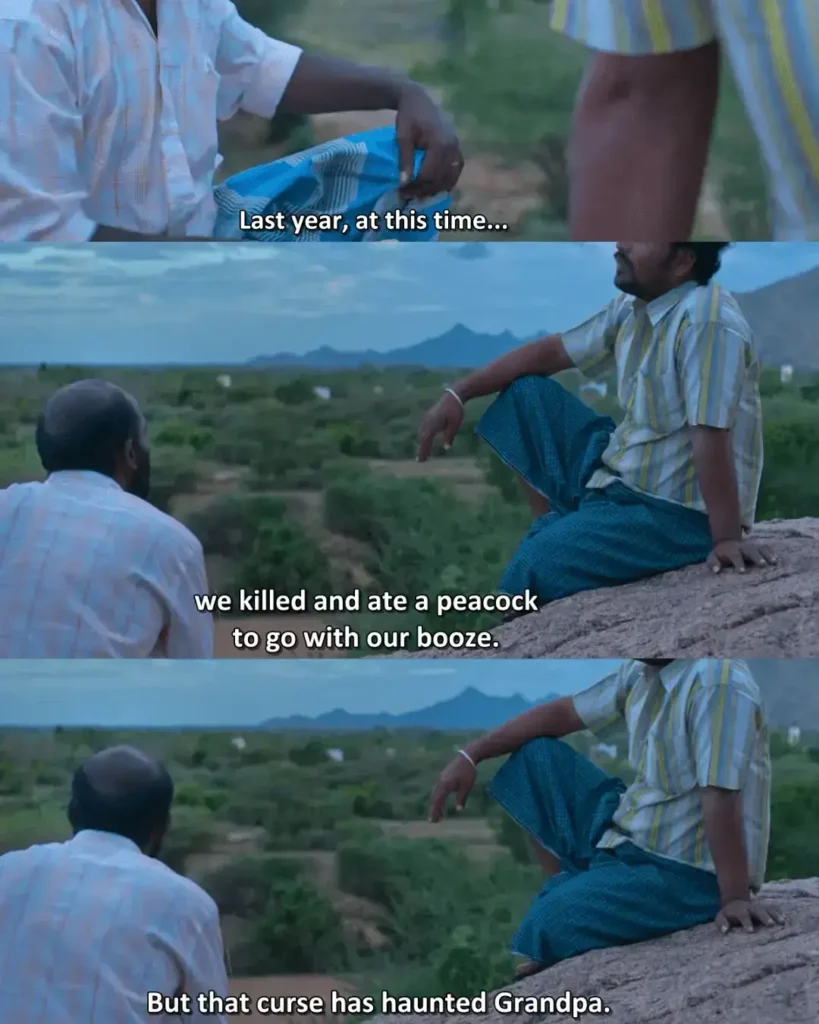
Let’s explore some noteworthy examples:
Nalan Kumarasamy’s “Andavan Kattalai” examines the struggles of two individuals as they face the repercussions of their choices, illustrating the complex workings of Karma.
Kamal Hassan’s iconic film “Nayagan” portrays the journey of a gangster grappling with the Karmic consequences of his actions, ultimately seeking redemption.
Manikandan’s “Kutrame Thandanai” delves into the life of a man caught in a web of events driven by Karma, highlighting the impact of past actions on the present.

Films like “Dashavatharam,” “Super Deluxe,” and “Katradhu Tamizh” also explore the themes of Karma, inviting audiences to contemplate the interconnectedness of actions and their consequences.
Dharma: Morality and Ethical Duties
Hinduism embraces the concept of Dharma, encompassing moral and ethical duties. It recognizes that moral standards can vary based on circumstances, life stages, and social roles.
Abrahamic religions often adhere to a divine commandments and sins, where moral standards are considered fixed and rooted in the commands of God. In Hinduism it’s not black and white, rather it’s grey.
The conversation between Arjuna and Krishna during at Kuruskhetra is the proof for this.
“Better is one’s own dharma, though imperfectly performed, than the dharma of another well-performed. Better is death in one’s own dharma; the dharma of another is fraught with fear.” (Chapter 3, Verse 35)
Filmmaker Thiagaraja Kumaraja aptly captures this philosophy in his own words, “Yethu Thevaio Athu Dharamam” (What we need is Dharma).
Films like “Aaranya Kaandam” and “Super Deluxe” illustrate this philosophy, where the concepts of right and wrong become blurred. These works challenge viewers to navigate through the shades of gray, exploring the complexities of morality and the multifaceted nature of human actions.

There is nothing absolute right or wrong; it’s all depending upon the lenses and the needs. Essentially, It’s about you and your survival.
Maya: The Illusion of the Material World:
Hinduism introduces the concept of Maya, acknowledging that the phenomenal world is an illusion, and true reality lies beyond the perceptions of the senses.
In contrast, Abrahamic religions generally consider the physical world as real, created by god and not inherently illusory.
“The wise mourn neither for the living nor for the dead.” (Chapter 2, Verse 11)
Once again, director Thiagaraja Kumaraja delves into the concept of maya in his recent film “Ninaivo Oru Paravai,” questioning the boundaries between reality and imagination.
To read more about Ninaivo Oru Paravai click here.

Even Thiagaraja Kumaraja’s “Super Deluxe” talks about the same in the end with the characters alien and Gajji.

Films like “Bogan” by Lakshman, “Awe” by Prashanth Verma, “Kadaisi Vivasayi” (Vijay Sethupathi track) by Manikandan, “Diary” by Arulnithi, “Eeram” by Arivazhagan, “Karnan” by Mari Selvaraj, and “Deja Vu” by Arvind Srinivasan also touch upon the theme of Maya. One personal favorite is Nalan Kumarasami’s “Soodhu Kavvum.“
These films challenge our perception of reality, inviting us to contemplate the illusory nature of the material world and the deeper truths that lie beyond.
Panentheism: Divine Presence in Nature
One striking aspect of Hinduism is its belief in panentheism, acknowledging the divine presence within all aspects of the natural world.
This one is my personal favourite philosophy considering Hinduism as a way of life. All the ancient civilisations followed this.
This sets it apart from the monotheistic beliefs of Abrahamic religions, which emphasize the existence of a singular God or Supreme God.
Hinduism perceives the divine as immanent within nature and all living beings.
I remember when I was a child, I was scared of a centipede and tried to kill it. Then my grandma shouted at me, “Lakshmi Devi” will curse me if I kill a centipede. Because the centipede is Lakshmi Devi’s chariot. This might sound ridiculous, but there is a strong impact on nature. After that incident I never intentionally hurt any animals or reptiles, be they a snake, a spider, a lizard, or a dog. It’s a fear, for a good cause.
Everything in nature is related to God. From Ganges, Himalayas, Rats, Snakes to even Ashes.
This pantheistic approach fosters a deep sense of interconnectedness, reverence, and responsibility towards the nature..
Environmental Conservation and Sustainability
Hinduism’s panentheistic perspective aligns harmoniously with efforts towards environmental conservation and sustainability. By recognizing the divinity in nature, Hinduism instills a profound respect for and protection of the environment. It promotes the idea that humans have a sacred duty (dharma) to preserve and care for the natural world, perceiving it as an integral part of their spiritual journey.
The film “Kadaisi Vivasayi” directed by Manikandan, serves as a remarkable example that exemplifies these themes.

Kadaisi Vivasayi’s title card is shown with a shot of a peakcock on the rock and a song in the background, which translates to “Whether you are a figment of imaginations or an idol made by humans, Muruga, you have a boundless devotion.”

In the movie, later, the farmer asks the court, “How can I kill Murugan’s peacocks?” Will write another post on this soon.
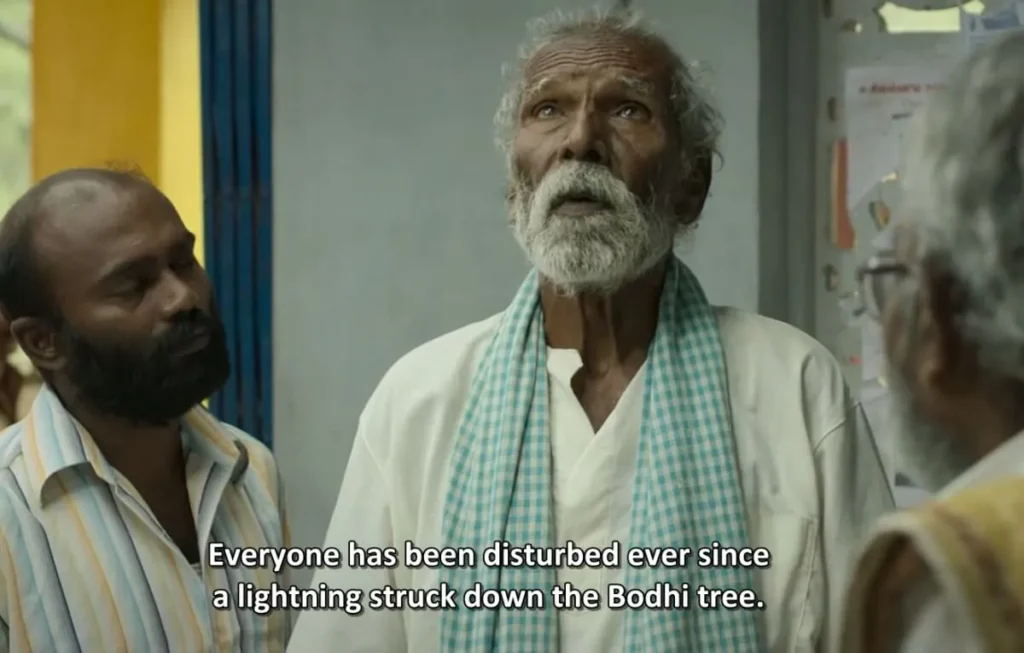
Through the portrayal of peacocks, paddy fields, trees, and stones as divine entities, the movie beautifully captures the interconnectedness between humans and the natural world.

It emphasizes the significance of living in harmony with nature, showcasing the traditional practices of elderly farmers who deeply respect and protect the environment.
Personal Freedom and Fanaticism
It is essential to note that the philosophies discussed here aim to empower individuals rather than impose religious dogmas or the authority of a godman.
That is why I said, Hinduism is a way of life.
Unfortunately, some fanatics distort these philosophies in the name of culture and heritage, thereby disrupting the true essence of this “way of life” nature of Hinduism.
I have heard stories from my friends about the challenges they face when it comes to inter-religious marriages. They often share the consequences they encounter from church communities and religious dogmas.
In many cases, if they marry someone from another religion, the expectation is that the non-islamic partner must convert, or else the community may resort to ostracizing the family.
It’s disheartening to witness the impact of such rigid beliefs on personal choices and the potential for social exclusion.
Thankfully, as a Hindu, I have the freedom to marry a girl from any community without interference from temples or pandits. However, I am concerned that these fanatics may soon infringe upon this freedom of choice in the name of religion and culture.
In my opinion, those who attempt to confine this vast philosophy within rigid structures and commandments are the ones who are anti-Hindu.
On the other hand, those who promote the philosophy and question or criticise the evils in beliefs can be considered pro-Hindu.
Comment your thoughts.